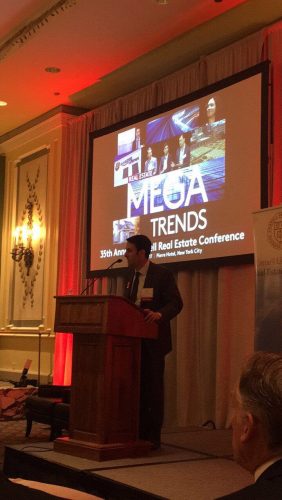
On October 13, 2017, the 35th annual Cornell Real Estate took place at the Pierre Hotel in Manhattan. Over 300 people attended the conference, including students, faculty, and industry professionals. The topic of the conference was “Mega Trends Impacting The Real Estate Industry”. The conference was an attempt to ask the major changes in where and how we live, work, shop and travel. Are these trends cyclical or secular? What can industry participants do to prepare for, participate in, and profit from these changes?

After an engaging introduction from David Rupert, President at Griffin Capital Capital and one of the founding Board Members of the Cornell Baker Program in Real Estate, the conference kicked off with the 2017 Hodes Weill Institutional Real Estate Allocations Monitor. Jiwon Park, Baker ’18, began the discussion by talking about what the Allocations Monitor is. The goal of the yearly Allocations Monitor is to interview companies and find out where capital is deployed. Over 244 companies responded to the 25-question survey, representing over $11 trillion in funds across the globe.
Next, Doug Weill, Managing Partner at Hodes Weill presented the findings of the 2017 Institutional Real Estate Allocations Monitor. One interesting bit of knowledge is that companies have now passed the 10% threshold in percentage of cumulative assets targeted to allocate into real estate. The number went from a 9.9% target in 2016 to 10.1% in 2017. But companies have gone from being moderately optimistic about the industry to being slightly pessimistic. One way to measure this is that 60% of companies are now deploying debt strategies – up from 50% in 2013. Overall, students and professionals alike were excited to hear of the allocations monitor. “Analyzing capital flows is the secret to understanding where the market is headed,” said Peter Romano, second year Baker Program in Real Estate student.

After the findings of the Allocation Monitor were presented, the “Institutional Perspective: Real Estate Allocations and Mega Trends Impacting Global Investing” panel kicked off with Tom Arnold, Global Head of Real Estate at Abu Dhabi Investment Authority (ADIA) and moderated by David Hodes, Managing Partner at Hodes Weill. The topic of the US investible market came up, including discussions on how some secondary markets stood to benefit from the current economic environment. The discussion then transitioned into talking about the gears of the market, including technology in real estate and how it could become a disruptive force in the coming years. Mr. Arnold wrapped up the panel with words of advice for students in the conference, including wisdom on how students should pursue entrepreneurial endeavors.
Next came the one on one discussion of “How and Where We Shop”, moderated by Laura Pomerantz, Vice Chairman, Head of Strategic Accounts at Cushman & Wakefield, and Richard Baker, Governor and Executive Chairman of the Hudson Bay Company (HBC) and namesake of the Baker Program in Real Estate. Richard Baker was dynamic and engaging in his discussion, as the direction of retail real estate as a whole was discussed. Mr. Baker consistently dismissed the notion that “retail real estate is dead”. He points out that over 85% of shopping is still done in person, and that the main issue is that the US is simply massively overbuilt in the retail sector. He also believes that the problems are both structural, from the overbuilding, and cyclical. Mr. Baker believes that one sector that stands to benefit greatly is the suburban strip centers near large metropolitan cities. One city he pointed out to as an example was Stamford, Connecticut, a city which acts as a suburb to New York. Strip centers in suburbs like that, argues Mr. Baker, currently have very little to no vacancy. After talking briefly about how he sees brick and mortar becoming a supporting asset to online sales, Mr. Baker answered questions form the audience on a multitude of topics.

Following Mr. Baker’s panel came “How and Where We Work” with David Fano, Chief Development Officer at WeWork and moderated by Jeffrey Horowitz, Global Head of Real Estate, Gaming and Lodging at Bank of America Merrill Lynch. The panel discussed how we are rethinking the use of office space, from both a productivity and from an efficiency standpoint. Mr. Fano talked about how WeWork hopes to change the idea that real estate is permanent, and turn it into an asset class that is flexible like social media. The company also makes sure that all the amenities that are provided are actually being used, and if not, helps find new ways to allocate their capital. To do this, WeWork hires community managers to keep an eye out on sites and see what aspects are being utilized. Mr. Fano believes that WeWork is in the community business, not the real estate business, and strives to help the company live by that ideal.
The final panel of the morning was a one-on-one discussion on “How Trends in Tech are Changing the Way We Design and Build”. The conversation was between Kai-Uwe Bergmann, Partner at Bjarke Ingels Group, and David Kaplan, Senior Partner at FXFOWLE. The conversation began with Mr. Bergmann discussing his project with Audi. Mr. Bergmann detailed how Audi came to him asking how they should change their reputation with the youth, as they noticed nearly all renderings done by architects nowadays promote walk-ability and no longer have cars in them. Mr. Bergmann advised them to rebrand themselves as a “mobility” company, not a “car” company. The conversion, deep and engaging, centered around what the future of society means for real estate. For example, one fascinating discussion was on roads. Over 15% of most cities are roads, but with the advent of the driverless car, Mr. Bergmann estimates only 5% of roads will be needed to supply cars in the coming future. What will the other 10% become? Will it go to real estate development, or become parks and nature?
As the morning came to a close, students reflected on what they learned and expressed excitement for the second half, including the presentation of Cornell’s “2017 Real Estate Industry Leader Award” to Jonathan Rose.
